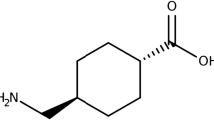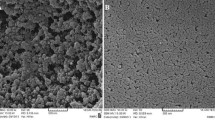Abstract
Pheochromocytoma and paraganglioma (PPGL) are rare neuroendocrine tumors arising from adrenal and extra-adrenal chromaffin cells. They produce excessive amounts of catecholamines and their metabolites. A newly analytical procedure based on the semi-automated microextraction by packed sorbent (MEPS) technique, using a digitally controlled syringe (eVol) combined with liquid chromatography-tandem mass spectrometry (LC-MS/MS), was developed to quantify free urinary catecholamines and metanephrines. The important parameters affecting MEPS performance, namely the type of sorbent material (porous graphitized carbon (PGC), polar enhanced polymer (PEP), cation-exchange (CX) and C18), number of extraction cycles, and elution solvent system, were evaluated. The optimal experimental conditions involved the loading of sample mixture in seven extraction cycles through a C18 sorbent in a MEPS syringe, followed by using elution solutions (water/acetonitrile/formic acid, 95/4.75/0.25). The entire sample preparation took about 4 min. Chromatographic separation was well achieved with an HSS PFP column using the gradient elution. The linearity range of the method was 0.167–33.4 ng/mL for epinephrine, 0.650–130 ng/mL for norepinephrine, 1.53–306 ng/mL for dopamine, 1.34–268 ng/mL for metanephrine, 3.43–686 ng/mL for normetanephrine, and 1.33–265 ng/mL for 3-methoxytyramine. The intra- and interassay precisions were ≤ 12.8%, and the respective accuracies were 88.4–112.0% and 89.0–109.5%. The carryover and sample stability without acidification were also investigated. Validation using clinical urine specimens showed that the proposed method had higher sensitivity compared with other urinary biochemical tests. The developed MEPS-LC-MS/MS method was simple, fast, and cost-effective; it helped to obtain information about multiple metabolites. It is applicable in routine clinical laboratories for the screening of PPGL.

Graphical abstract




Similar content being viewed by others
Abbreviations
- APS:
-
Amino-propyl silane
- CX:
-
Cation-exchange
- DA:
-
Dopamine
- DPB:
-
2-Aminoethyldiphenylborinate
- EPI:
-
Epinephrine
- ESI:
-
Electrospray ionization
- IS:
-
Internal standard
- LOQ:
-
Limit of quantification
- LOD:
-
Limit of detection
- ME:
-
Matrix effect
- MEPS:
-
Microextraction by packed sorbent
- MN:
-
Metanephrine
- MRM:
-
Multiple reaction monitoring
- NE:
-
Norepinephrine
- NMN:
-
Normetanephrine
- PPGL:
-
Pheochromocytoma and paraganglioma
- PGC:
-
Porous graphitized carbon
- PEP:
-
Polar enhanced polymer
- QC:
-
Quality control
- SPE:
-
Solid phase extraction
- SD:
-
Standard deviation
- 3-MT:
-
3-Methoxytyramine
References
Manger WM, Gifford RW. In clinical and experimental pheochromocytoma. 2nd ed. Cambridge: Blackwell Science; 1996.
Manger WM, Gifford RW. Pheochromocytoma. J Clin Hypertens. 2002;4:62–72.
Lenders JW, Duh QY, Eisenhofer G, Gimenez-Roqueplo AP, Grebe SK, Murad MH, et al. Pheochromocytoma and paraganglioma: an endocrine society clinical practice guideline. J Clin Endocrinol Metab. 2014;99:1915–42.
Pacak K, Eisenhofer G. An assessment of biochemical tests for the diagnosis of pheochromocytoma. Nat Clin Pract Endocrinol Metab. 2007;3:744–5.
Chen H, Sippel RS, O’Dorisio MS, Vinik AI, Lloyd RV, Pacak K. The North American neuroendocrine tumor society consensus guideline for the diagnosis and management of neuroendocrine tumors: pheochromocytoma, paraganglioma, and medullary thyroid cancer. Pancreas. 2010;39:775–83.
Dubois LA, Gray DK. Dopamine-secreting phenochromocytoma: in search of a syndrome. World J Surg. 2005;29:909–13.
Eisenhofer G. Free or total metanephrines for diagnosis of pheochromocytoma: what is the difference? Clin Chem. 2001;47:988–9.
Simonin J, Gerber-Lemaire S, Centeno C, Seghezzi C, Iglesias K, Abid K, et al. Synthetic calibrators for the analysis of total metanephrines in urine: revisiting the conditions of hydrolysis. Clin Chem Acta. 2012;413:998–1003.
Lenders JWM, Pacak K, Walther MM, Linehan WM, Mannelli M, Friberg P, Keiser HR, Goldstein DS, Eisenhofer G. Biochemical diagnosis of pheochromocytoma - which test is best? JMMA 2002; 287: 1427–1434.
Peitzsch M, Pelzel D, Glockner S, Prejbisz A, Fassnacht M, Beuschlein F, et al. Simultaneous liquid chromatography tandem mass spectrometric determination of urinary free metanephrines and catecholamines, with comparisons of free and deconjugated metabolites. Clin Chem Acta. 2013;418:50–8.
Woo HI, Yang JS, Oh HJ, Cho YY, Kim JH, Park HD, et al. A simple and rapid analytical method based on solid-phase extraction and liquid chromatography-tandem mass spectrometry for the simultaneous determination of free catecholamines and metanephrines in urine and its application to routine clinical analysis. Clin Biochem. 2016;49:573–9.
Barron J. Phenochromocytoma: diagnostic challenges for biochemical screening and diagnosis. J Clin Pathol. 2010;63:669–74.
Li XG, Li S, Kellermann G. Pre-analytical and analytical validations and clinical applications of a miniaturized, simple and cost-effective solid phase extraction combined LC-MS/MS for the simultaneous determination of catecholamines and metanephrines in spot urine samples. Talanta. 2016;159:238–47.
Ellis AG, Zeglinski PT, Coleman KE, Whiting MJ. Dilute, derivatise and shoot: measurement of urinary free metanephrines and catecholamines as ethyl derivatives by LC-MSMS. Clin Mass Spectrom. 2017;4-5:34–41.
Xie ZZ, Lorkiewicz P, Riggs DW, Bhatnagar A, Srivastava S. Comprehensive, robust, and sensitive UPLC-MS/MS analysis of free biogenic monoamines and their metabolites in urine. J Chromatogr B. 2018;1099:83–91.
Taylor RL, Singh RJ. Validation of liquid chromatography-tandem mass spectrometry method for analysis of urinary conjugated metanephrine and normetanephrine for screening of pheochromocytoma. Clin Chem. 2002;48:533–9.
Whiting MJ. Simultaneous measurement of urinary metanephrines and catecholamines by liquid chromatography with tandem mass spectrometric detection. Ann Clin Biochem. 2009;46:129–36.
Gabler J, Miller A, Wang S. A simple liquid chromatography-tandem mass spectrometry method for measuring metanephrine and normetanephrine in urine. Clin Chem Lab Med. 2011;49:1213–6.
Clark ZD, Frank EL. Urinary metanephrines by liquid chromatography tandem mass spectrometry: using multiple quantification methods to minimize interferences in a high throughput method. J Chromatogr B. 2011;879:3673–80.
Lu HH, Yu J, Wang J, Wu LL, Xiao H, Gao R. Simultaneous quantification of neuroactive dopamine serotonin and kynurenine pathway metabolites in gender-specific youth urine by ultra performance liquid chromatography tandem high resolution mass spectrometry. J Pharm Biomed Anal. 2016;122:42–51.
Kushnir MM, Urry FM, Frank EL, Rober WL, Shushan B. Analysis of catecholamines in urine by positive-ion electrospray tandem mass spectrometry. Clin Chem. 2002;48:323–31.
Bicker J, Fortuna A, Alves G, Falcao A. Liquid chromatographic methods for the quantification of catecholamines and their metabolites in several biological samples-a review. Anal Chim Acta. 2013;768:12–34.
Yang L, Saind R, Abdel-Rehim M. Sorbent, device, matrix and application in microextraction by packed sorbent (MEPS): a review. J Chromatogr B. 2017;1043:33–43.
Abdel-Rehim M. Recent advances in microextraction by packed sorbent for bioanalysis. J Chromatogr A. 2010;1217:2569–80.
Saracino MA, Santarcangelo L, Raggi MA, Mercolini L. Microextraction by packed sorbent (MEPS) to analyze catecholamines in innovative biological samples. J Pharm Biomed Anal. 2015;104:122–9.
Konieczna L, Roszkowska A, Synakiewicz A, Stachowicz-Stencel T, Adamkiewicz-Drozynska E, Baczek T. Analytical approach to determining human biogenic amines and their metabolites using eVol microextraction in packed syringe coupled to liquid chromatography mass spectrometry method with hydrophillic interaction chromatography column. Talanta. 2016;150:331–9.
Moein MM, Abdel-Rehim A, Abdel-Rehim M. Microextraction by packed sorbent (MEPS). Trend Anal Chem. 2015;67:34–44.
CLSI, Interference Testing in Clinical Chemistry: Approval Guideline, second ed. Clinical and Laboratory Standards Institute, Wsyne, PA, 2005 CLSI document EP7-A2.
Annesley TM. Ion suppression in mass spectrometry. Clin Chem. 2003;49:1041–4.
Wright MJ, Thomas RL, Stanford PE, Horvath AR. Multiple reaction monitoring with multistage fragmentation (MRM3) detection enhances selectivity for liquid chromatography-tandem mass spectrometry analysis of plasma free metanephrines. Clin Chem. 2015;61:1–9.
Peitzsch M, Adaway JE, Eisenhofer G. Interference from 3-O-methyldopa with ultra-high performance LC-MS/MS measurements of plasma metanephrines: chromatographic separation remains important. Clin Chem. 2015;61:993–6.
Dunand M, Donzelli M, Richli A, Hysek CM, Liechti ME, Grouzmann E. Analytical interference of 4-hydroxy-3-methoxymethamphetamine with the measurement of plasma free normetanephrine by ultra-high pressure liquid chromatography-tandem mass spectrometry. Clin Biochem. 2014;47:1121–3.
Shen Y, Cheng LM, Guan Q, Li HJ, Lu J, Wang X. Development and validation of a liquid chromatography tandem mass spectrometry method for the measurement of urinary catecholamines in diagnosis of pheochromocytoma. Biomed Chromatogr. 2017;31:e4003.
Clark ZD, Cutler JM, Pavlov IY, Strathmann FG, Frank EL. Simple dilute-and-shoot method for urinary vanillylmandelic acid and homovanillic acid by liquid chromatography tandem mass spectrometry. Clin Chim Acta. 2017;468:201–8.
Eisenhofer G, Peitzshch M, Kaden D, Langton K, Mangelis A, Pamporaki C, et al. Reference intervals for LC-MS/MS measurements of plasma free, urinary free and urinary acid-hydrolyzed deconjugated normetanephrine, metanephrine and methoxytyramine. Clin Chim Acta. 2019;490:46–54.
Funding
This study received financial support from the National Natural Science Foundation of China NSFC-81672107 and NSFC-21405007.
Author information
Authors and Affiliations
Corresponding author
Ethics declarations
Conflict of interest
The authors declare that they have no conflicts of interest.
Ethical approval
The ethical committee of Peking University Third Hospital approved the study.
Additional information
Publisher’s note
Springer Nature remains neutral with regard to jurisdictional claims in published maps and institutional affiliations.
Electronic supplementary material
ESM 1
(PDF 320 kb)
Rights and permissions
About this article
Cite this article
Xiong, X., Zhang, Y. Simple, rapid, and cost-effective microextraction by the packed sorbent method for quantifying of urinary free catecholamines and metanephrines using liquid chromatography-tandem mass spectrometry and its application in clinical analysis. Anal Bioanal Chem 412, 2763–2775 (2020). https://doi.org/10.1007/s00216-020-02436-8
Received:
Revised:
Accepted:
Published:
Issue Date:
DOI: https://doi.org/10.1007/s00216-020-02436-8




